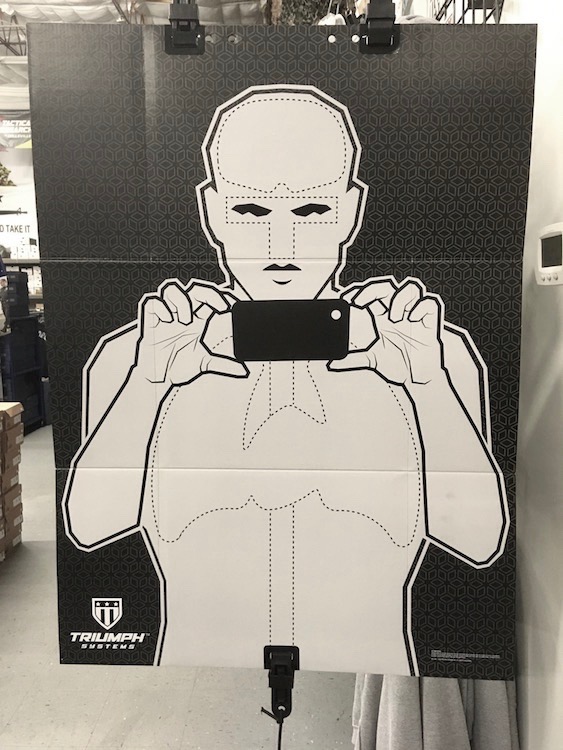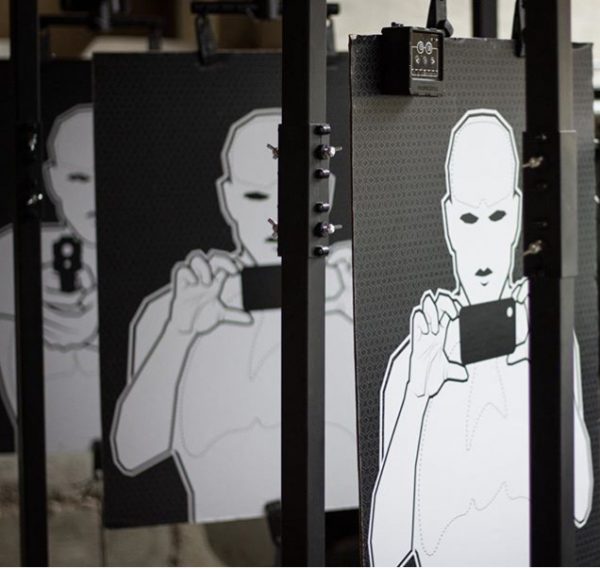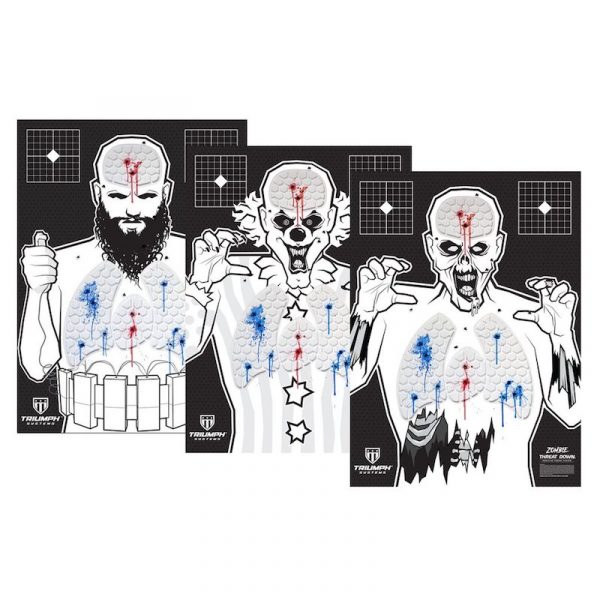Several weeks ago I was browsing through an army surplus and tactical shop in Houston. I come from a military family, and my late father was a sheriff, and I sometimes wax sentimental for the kind of gear you can find in these places — this particular store focuses on SWAT, military, and police equipment, but it sells to the general public.
I rounded the corner and came face-to-face with a military-decked mannequin facing a target of a man holding a cell phone. My gut reaction to this confrontation was intense. I grew up in the midwest, and my family were avid hunters, which meant every household had a lot rifles, as well as small arms. It was common for us to go shooting at targets, and for a rifle to be stored under the seat of a truck.
But this store display really unsettled me. A shelving system right next to it held conceal holsters, ammunitions carriers, and replica guns and rifles. A TV above the target showed a video of tactical firing positions and stances. But right next to it, the target image was of a person holding a cell phone. A threat?
When I got home I did some online research, and found out that the target image was a “Threat/No Threat” practice target. The Threat/No Threat image set was created by Triumph Systems. The idea is that one side shows a person with a gun (a Threat) and the other side (No Threat) shows a person holding a cell phone. The target is meant to rotate, and train people in tactical industries (or, presumably, the general public shopping at an Army surplus store) when to shoot while under pressure.
Training I understand — the cell phone side of a rotating image not so much. Here’s why: The way this particular rotating target would cause unlikely confusion in a trainee is problematic. Both targets have vitals outlined: the t-zone of the eyes and nose; the heart, lungs, and brain, and the spine. Most shooting targets don’t go into so much detail, because in that split-second of decision making (remember this target is rotating), targeting specifics vitals would be difficult, if not impossible. And for the No Threat target, it would be a tragedy if you hit it at all, regardless of outlined vitals. The vitals are mute. A decorative blur. All you’d see is a person with a cell phone, used or not used as a ‘weapon’ against the shooter.
The power of language and images is more charged than ever, especially in our digital age, and the information we receive through images (and language) is coming at us with unprecedented velocity. Details are lost, and reactions are often instant: Threat or No Threat? Each individual’s response is at play here. When the American president says things like the press is “the enemy of the people” and “Media: enemy number one,” it’s easy to see how one image on a target that’s marketed to tactical teams as well as the general public might be a matter of not just poor taste, but poor judgement.
I dug a little further to figure out how the Threat/No Threat target series is being marketed. In the stores, it seems to be displayed with very little explanation to its purpose. A person holding a cell phone: just another target. On the company’s Instagram account I found a post that showed the cell-phone person target in mechanized line of targets. Some followers were either excited about this new target, or not aware of its purpose, or bewildered. Some followers commented about their confusion around the cell-phone image (the comments that hadn’t been deleted), and in some cases, I could see a response from the Triumph team about the target, but not the commenter’s original question.
Some of Triumph’s other threat targets include a sasquatch, a killer clown, a zombie — and an extremist with bombs around his waist, holding a detonator. The “fun” of shooting at mythical cartoon targets blurs quickly into the more “sincere” killing of a human threat. One Instagram follower commented: “Still trying to decide if @triumphsystems is training us to shoot bad guys or instagrammers 🙂 Nice system either way.”
Is an individual with a cell-phone camera a threat or not? Who decides this? Should we have to decide this? Shouldn’t this be an immediate No Threat? These days, plenty would argue that the perception of Threat is simply up to the beholder, totally subjective but also “real” to them, whether at target practice, or on social media, or out in the community. There’s a funny but telling scene in Donald Glover’s Atlanta that dips into into this problem: Darius gets plenty of pushback when he takes un ‘unacceptable” target image to a very white shooting range.
Pop artists and artists who regard advertising as insidious and problematic have been right all along, but now they’re more right than ever: We need to stay aware of the power of an image and its marketed meaning. Nuance is a casualty of our times, and now knee-jerk reactions are steering discourse and action. Propaganda looms.






